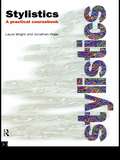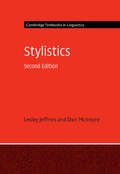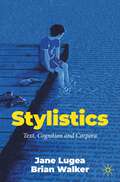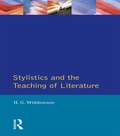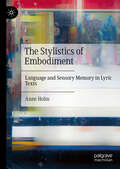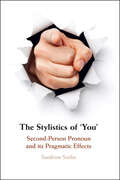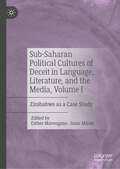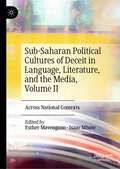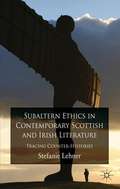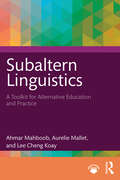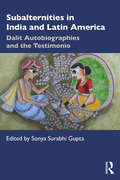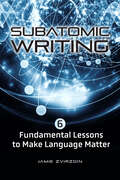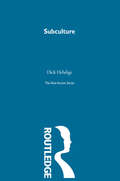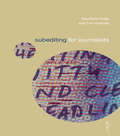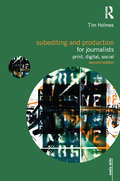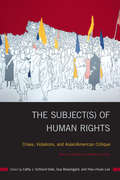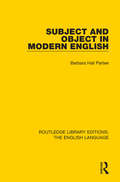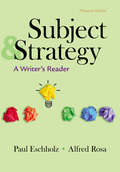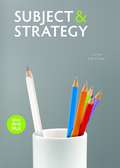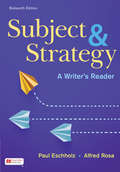- Table View
- List View
Stylistics: A Practical Coursebook
by Jonathan Hope Laura WrightUsing a wide range of twentieth-century literary prose Laura Wright and Jonathan Hope provide an `interactive' introduction to the techniques of stylistic analysis. Divided up into five sections; the noun phrase, the verb phrase, the clause, text structure and vocabulary, the book also provides an introduction to the basics of descriptive grammar for beginning students. * Presumes no prior linguistic knowledge * Provides a comprehensive glossary of terms * Adaptable: designed to be used in a variety of classroom contexts * Introduces students to an enormous range of 20th century literature from James Joyce to Roddy Doyle A practical coursebook rather than a survey account of stylistics as a discipline, the book provides over forty opportunities for hands-on stylistic analysis. For each linguistic feature under discussion the reader is offered a definition, a text for analysis, exercises and tasks, in addition to a suggested solution. Stylistics: A Practical Coursebook is genuinely `student friendly' and will be an invaluable tool for all beginning undergraduates and A-level students of language and literature.
Stylistics (Cambridge Textbooks in Linguistics)
by Lesley Jeffries Dan McIntyreStylistics is the linguistic study of style in language. Now in its second edition, this book is an introduction to stylistics that locates it firmly within the traditions of linguistics. Organised to reflect the historical development of stylistics, it covers key principles such as foregrounding theory, as well as recent advances in cognitive and corpus stylistics. This edition has been fully revised to cover all the major developments in the field since the first edition, including extensive coverage of corpus stylistics, new sections on a range of topics, additional exercises and commentaries, updated further reading lists, and an entirely re-written final chapter on the disciplinary status of stylistics and its relationship to linguistics, plus a manifesto for the future of the field. Comprehensive in its coverage and assuming no prior knowledge of the subject, it is essential reading for students and researchers new to this fascinating area of language study.
Stylistics
by Lesley Jeffries Dan McintyreStylistics is the linguistic study of style in language. It aims to account for how texts project meaning, how readers construct meaning and why readers respond to texts in the way that they do. This book is an introduction to stylistics that locates it firmly within the traditions of linguistics. Organised to reflect the historical development of stylistics from its origins in Russian formalism, the book covers key principles such as foregrounding theory, as well as more recent developments in cognitive stylistics. It includes an examination of both literary and non-literary texts, and substantial coverage of methodologies for stylistic analysis. Throughout the book, the emphasis is on the practicalities of producing stylistic analyses that are objective, replicable and falsifiable. Comprehensive in its coverage and assuming no prior knowledge of the topic, Stylistics will be essential reading for undergraduate and graduate students new to this fascinating area of language study.
Stylistics: Text, Cognition and Corpora
by Jane Lugea Brian WalkerThis textbook introduces the reader to contemporary approaches to language analysis such as cognitive stylistics and corpus stylistics, reflecting recent shifts in research trends and offering students a practical way to access and understand these developments. The authors lead readers through detailed explanations, guided analyses, examples of research and suggestions for further reading. This textbook makes an ideal introduction to the field of stylistics for students who are new to the area, but who have some background in basic language analysis. It will be of use to students on courses in stylistics, literary linguistics, corpus methods, cognitive linguistics, and language and style.
Stylistics and Psychology: Investigations of Foregrounding (Routledge Revivals)
by Willie Van PeerFirst published in 1986, Stylistics and Psychology is an empirical investigation into foregrounding. The theory of foregrounding has received little in the way of empirical testing within the field of stylistics and literary criticism. The book engages extensively with the author’s own research involving psychological testing and provides a rigorous, scientific approach to stylistics. It presents evidence of a general link between foregrounding and evaluation, apparent in correlations between foregrounding and evaluation, between foregrounding and reader preference, and between foregrounding and readers’ evaluative associations. Stylistics and Psychology will appeal to those with an interest in literary criticism and linguistics.
Stylistics and the Teaching of Literature (Applied Linguistics and Language Study)
by H. G. WiddowsonFirst published in 1976. Routledge is an imprint of Taylor & Francis, an informa company.
The Stylistics of Embodiment: Language and Sensory Memory in Lyric Texts
by Anne HolmThis book presents a stylistic framework for analysing embodiment in lyric texts. While the assumption that our minds are embodied underlies most approaches in cognitive stylistics (and beyond), a systematic account of the linguistic patterns through which the body may be manifested in poetic expression has not yet been provided. Aiming to fill this gap, the book focuses on contemporary lyric texts that prominently engage the senses in depicting past experiences. Drawing its tools mainly from Cognitive Grammar and research on conceptual metaphors and iconicity, the book investigates how sensory language gives rise to simulated embodied responses. In doing so, the book views poetic expression as a complex interplay of modalities and seeks to expand the concept of the lyric by incorporating digital poetry, song lyrics, performance poetry and lyrical prose among its case studies. The book furthermore brings in current cognitive scientific research on the workings of memory to the analysis of sensory memory, most centrally the psychological phenomenon of mental time travel. It will be of interest to students and scholars working on stylistics, literary studies, and multimodal and intermedial studies.
The Stylistics of ‘You': Second-Person Pronoun and its Pragmatic Effects
by Sandrine SorlinThis book takes 'you', the reader, on board an interdisciplinary journey across genre, time and medium with the second-person pronoun. It offers a model of the various pragmatic functions and effects of 'you' according to different variables and linguistic parameters, cutting across a wide range of genres (ads, political slogans, tweets, news presentation, literary genres etc.), and bringing together print and digital texts under the same theoretical banner. Drawing on recent research into intersubjectivity in neuropsychology and socio-cognition, it delves into the relational and ethical processing at work in the reading of a second-person pronoun narrative. When 'you' takes on its more traditional deictic function of address, the author-reader channel can be opened in different ways, which is explored in examples taken from Fielding, Brontë, Orwell, Kincaid, Grimsley, Royle, Adichie, Bartlett, Auster, and even Spacey's 'creepy' 2018 YouTube video, ultimately foregrounding continuities and contrasts in the positioning of the audience.
Sub-Saharan Political Cultures of Deceit in Language, Literature, and the Media, Volume I: Zimbabwe as a Case Study
by Esther Mavengano Isaac MhuteThis two-volume set charts a cross-disciplinary discursive terrain that proffers rich insights about deceit in contemporary postcolonial Sub-Saharan African politics. In an attempt to produce a nuanced and multi-faceted academic dialoguing platform, the two volumes have a particular focus on the aspects of treachery, fear of difference (oppositional politics), and discourses/ semiotics of mis/self- representation. The major aim of the proposed volumes is to contribute toward the often problematised conversations about the unfolding (post)colonial Sub-Saharan world which is topical in decolonial and Pan-African studies. The volumes seek to place political thinking and postcolonial political systems under the scholarly gaze with the view to highlight and enhance the participation of African cross-disciplinary scholarship in the postcolonial political processes of the continent. Most significantly, it is through such probing of the limitations of our own disciplinary perspectives which can help us appreciate the complexity of the postcolonial Sub-Saharan African politics. The first volume uses Zimbabwe as a case study, while the second volume broadens to examine postcolonial politics in Sub-Saharan Africa more broadly.
Sub-Saharan Political Cultures of Deceit in Language, Literature, and the Media, Volume II: Across National Contexts
by Esther Mavengano Isaac MhuteThis two-volume set charts a cross-disciplinary discursive terrain that proffers rich insights about deceit in contemporary postcolonial Sub-Saharan African politics. In an attempt to produce a nuanced and multifaceted academic dialoguing platform, the two volumes have a particular focus on the aspects of treachery, fear of difference (oppositional politics), and discourses/semiotics of mis/self-representation. The major aim of the proposed volumes is to contribute toward the often problematised conversations about the unfolding (post)colonial Sub-Saharan world which is topical in decolonial and Pan-African studies.The volumes seek to place political thinking and postcolonial political systems under the scholarly gaze with the view to highlight and enhance the participation of African cross-disciplinary scholarship in the postcolonial political processes of the continent. Most significantly, it is through such probing of the limitations of our own disciplinary perspectives which can help us appreciate the complexity of the postcolonial Sub-Saharan African politics. The first volume uses Zimbabwe as a case study, while the second volume examines postcolonial politics in Sub-Saharan Africa more broadly.The first volume uses Zimbabwe as a case study, while the second volume examines postcolonial politics in Sub-Saharan Africa more broadly.The first volume uses Zimbabwe as a case study, while the second volume examines postcolonial politics in Sub-Saharan Africa more broadly.
Subaltern Ethics in Contemporary Scottish and Irish Literature
by Stefanie LehnerRecent decades have not only seen an increasing interest in the political and economic crosscurrents between Scotland and Ireland, but they have also witnessed a remarkable literary renaissance on both sides of the Irish Sea. Subaltern Ethics breaks new ground in theoretical investigations of the overlapping of Irish and Scottish studies. Its approach galvanises Emmanuel Levinas' ethics with the socio-cultural category of the 'subaltern' to arrive at a rigorous position of politicised postcolonial theory. This innovative Irish-Scottish comparative framework enables Stefanie Lehner to trace a shared matrix of politico-ethical concerns in contemporary Scottish, Northern Irish and Irish writings. The book sheds new light on established and more recent writers, including James Kelman, Patrick McCabe and Glenn Patterson, exploring how their fictions interact with recent political developments, concerning the impact of the Celtic Tiger in the Republic, devolution in Scotland, and the peace process in Northern Ireland. It argues that these works register a recalcitrance towards dominant historical paradigms, thereby constructing 'counter-histories' to the alleged (d)evolutionary processes in today's Atlantic archipelago.
Subaltern Linguistics: A Toolkit for Alternative Education and Practice
by Ahmar Mahboob Aurelie Mallet Lee Cheng KoaySubaltern Linguistics challenges the goals and theoretical foundations of colonial linguistics, academia, and education and provides alternative approaches and practices. The goal of subaltern practice is to create economies, projects, and resources that can be made and used by community members and leaders to develop and promote community beneficial projects in their own language (or a language of their choice). In doing subaltern and CREDIBLE work, we need to develop a new array of tools and resources. This book provides a broad introduction for how this can be done along with examples of multiple CREDIBLE projects carried out by students and members of the broader community.Part I establishes the need for this work, introduces some concepts that the CREDIBLE approach draws on, and explains CREDIBLE projects. Part II delineates what can be done while adopting a CREDIBLE approach, including several examples of student projects across a range of areas such as education, environment, healthcare and economic development. Part III provides detailed guidelines and instructions on how to develop CREDIBLE projects with worksheets and activities that can be used to conceptualise, plan, and develop CREDIBLE projects. Finally, Part IV includes four CREDIBLE project reports as examples of how this work can be written up for wider dissemination.This text is an essential guide to a new way of doing linguistics, reflecting the diversity and richness of today’s world.
Subalternities in India and Latin America: Dalit Autobiographies and the Testimonio
by Sonya Surabhi GuptaThis volume presents a comparative exploration of Dalit autobiographical writing from India and of Latin American testimonio as subaltern voices from two regions of the Global South. Offering frames for linking global subalternity today, the chapters address Siddalingaiah’s Ooru Keri; Muli’s Life History; Manoranjan Byapari and Manju Bala’s narratives; and Yashica Dutt’s Coming Out as Dalit; among others, alongside foundational texts of the testimonio genre. While embedded in their specific experiences, the shared history of oppression and resistance on the basis of race/ethnicity and caste from where these subaltern life histories arise constitutes an alternative epistemological locus. The chapters point to the inadequacy of reading them within existing critical frameworks in autobiography studies. A fascinating set of studies juxtaposing the two genres, the book is an essential read for scholars and researchers of Dalit studies, subaltern studies, testimonio and autobiography, cultural studies, world literature, comparative literature, history, political sociology and social anthropology, arts and aesthetics, Latin American studies, and Global South studies.
Subatomic Writing: Six Fundamental Lessons to Make Language Matter
by Jamie ZvirzdinSee science writing fundamentals afresh through a subatomic lens!In Subatomic Writing, Johns Hopkins University instructor Jamie Zvirzdin goes bravely into uncharted territory by offering a totally new kind of guide for writing about science—from the subatomic level up! Subatomic Writing teaches readers that the building blocks of language are like particles in physics. These particles, combined and arranged, form something greater than their parts: all matter in the literary universe. The six levels of language covered in this guide create writing that illuminates and energizes the reader to feel, learn, change, and act. This interdisciplinary approach helps scientists, science writers, and editors improve their writing in fundamental areas as they build from the sounds in a word to the pacing of a paragraph. These areas include• Sound and sense• Word classes• Grammar and syntax• Punctuation• Rhythm and emphasis• Pacing and coherenceEqually helpful for students who need to learn how to write clearly about science and scientists who need to hone their writing skills to create more effective course material, papers, and grant applications, this guide builds confidence in writing abilities as old skills are taught in new, exciting ways. Each lesson provides exercises that build on each other, strengthening readers' capacity to communicate ideas and data, all while learning basic particle physics along the way.
Subculture: The Meaning Of Style (New Accents Ser.)
by Dick HebdigeFirst Published in 2002. Routledge is an imprint of Taylor & Francis, an informa company.
Subediting and Production for Journalists: Print, Digital & Social
by Wynford Hicks Tim HolmesSubediting for Journalists is a concise, up-to-date and readable introduction to the skills of subediting for newspapers and magazines. It describes how subediting has developed, from the early days of printing to the modern era of computers and the web, and explains clearly what the sub now has to do.Using practical examples from newspapers and magazines, Subediting for Journalists introduces the various techniques involved in subediting from cutting copy to writing cover lines. It includes:*house style explained with model stylebook provided*examples of bad journalistic English such as misused clichés and pronoun confusion*subbing news and features for sense and style*editing quotes and readers' letters*projecting copy by writing headlines and standfirsts*checking pictures and writing captions*principles and methods of proofreading*making copy legally safe*understanding production and using software packages *website subbing*a glossary of journalistic terms and suggestions for further reading
Subediting and Production for Journalists: Print, Digital & Social (Media Skills)
by Tim HolmesThe new edition of Subediting and Production for Journalists is a concise, clear and contemporary introduction to the skills required for subediting newspapers, magazines and websites. Tim Holmes describes how subediting has developed, from the early days of print to the modern era of the internet browser and social media, and explores the many challenges for the sub working today. Using numerous practical examples drawn from print and online, Subediting and Production for Journalists introduces the various techniques employed by the sub to help make the written word stand out on the page, including: subbing news and features for sense and style writing headlines and sells making copy legally safe understanding production, using software packages and content management systems editing and rewriting stories for online publication creating suitable page furniture for websites handling and sizing pictures digitally handling audio and video. Subediting and Production for Journalists is the perfect guide for all those with an interest in subbing in today’s multimedia environments, as well as anyone wanting to see their words come to life.
Subhashika Dviteeyo Bhag class 7 - JCERT: सुभाषिका द्वितीयो भागः ७वीं कक्षा - जेसीईआरटी
by Jharkhand Shaikshik Anusandhan Evam Prashikshan Parishad Ranchi"सुभाषिका" द्वितीयो भाग झारखंड शैक्षिक अनुसंधान एवं प्रशिक्षण परिषद द्वारा प्रकाशित संस्कृत की पाठ्यपुस्तक है, जिसका उद्देश्य कक्षा 7 के छात्रों को संस्कृत भाषा का बुनियादी ज्ञान प्रदान करना है। यह पुस्तक विशेष रूप से संस्कृत भाषा की महत्ता और उसकी सांस्कृतिक धरोहर को समझाने पर केंद्रित है। इसमें 16 पाठ शामिल हैं, जिनमें कविताएँ, श्लोक, संवाद, कथाएँ और चित्रकथाएँ सम्मिलित हैं। प्रत्येक पाठ भाषा की सरलता और प्रवाह को ध्यान में रखते हुए तैयार किया गया है, ताकि छात्रों को संस्कृत भाषा से लगाव हो। पुस्तक में "गौरवम् संस्कृतम्" जैसे श्लोकों के माध्यम से संस्कृत भाषा की समृद्धि और गौरव को उजागर किया गया है, जबकि "बुद्धिर्यस्य बलं तस्य" जैसे पाठ बुद्धि की महत्ता पर बल देते हैं। इसके अतिरिक्त, पाठ्यक्रम में झारखंड की सांस्कृतिक विरासत को भी स्थान दिया गया है, जैसे "सरहुल पर्व" और भगवान बिरसा मुण्डा की गाथाएँ। इस पुस्तक का उद्देश्य विद्यार्थियों में संस्कृत भाषा के प्रति रुचि पैदा करना और उनके नैतिक और सांस्कृतिक विकास में योगदान देना है।
Subhashika Prathamo Bhag class 6 class - JCERT: सुभाषिका प्रथमो भागः ६वीं कक्षा - जेसीईआरटी
by Jharkhand Shaikshik Anusandhan Evam Prashikshan Parishad Ranchi"सुभाषीका" एक संस्कृत पाठ्यपुस्तक है जो झारखंड शैक्षिक अनुसंधान एवं प्रशिक्षण परिषद द्वारा प्रकाशित की गई है। यह पुस्तक झारखंड के विद्यार्थियों के लिए नि:शुल्क वितरित की जाती है और इसमें संस्कृत भाषा के प्राचीन साहित्य, व्याकरण, तथा शब्दावली का अध्ययन किया गया है। पुस्तक का मुख्य उद्देश्य विद्यार्थियों को संस्कृत भाषा की बुनियादी जानकारी देना और उन्हें भाषा की संरचना तथा साहित्य से परिचित कराना है। इसमें विभिन्न प्रकार के अभ्यास, कहानियाँ, श्लोक और शिक्षाप्रद कथाएँ शामिल हैं जो बच्चों में नैतिक मूल्यों का विकास करने के साथ-साथ उनकी भाषा कौशल को भी सुदृढ़ करते हैं। पुस्तक में संस्कृत वर्णमाला, शब्दरूप, धातुरूप और वाक्य रचना पर विशेष ध्यान दिया गया है, ताकि छात्रों को संस्कृत पढ़ने और समझने में आसानी हो। विभिन्न पाठ्यक्रम और शिक्षण विधियों को ध्यान में रखते हुए, इस पुस्तक में डिजिटल संसाधनों का भी समावेश किया गया है, जिससे शिक्षकों और छात्रों को अतिरिक्त शैक्षिक सामग्री तक पहुंचने में सुविधा होती है। कुल मिलाकर, यह पुस्तक विद्यार्थियों को संस्कृत भाषा की महत्ता और उसकी उपयोगिता से अवगत कराती है।
Subhashika Tritiyo Bhag class 8 - JCERT: सुभाषिका तृतीयो भागः ८वीं कक्षा - जेसीईआरटी
by Jharkhand Shaikshik Anusandhan Evam Prashikshan Parishad Ranchiयह सुभाषिका पाठ्यपुस्तक कक्षा 8 के छात्रों के लिए तैयार की गई है, जिसका उद्देश्य संस्कृत भाषा और नैतिक मूल्यों की शिक्षा देना है। इसमें 17 पाठ हैं, जिनमें से कुछ गद्यात्मक और कुछ पद्यात्मक हैं। पाठ्यक्रम में छात्रों को संस्कृत के सरल और प्रभावी तरीके से पढ़ाया जाता है, जिसमें संस्कृत श्लोक, कहानियाँ, और निबंध शामिल हैं। उदाहरण के लिए, नीतिश्लोक पाठ छात्रों को नैतिकता, सत्कर्म, और धैर्य के मूल्यों से परिचित कराता है, जबकि 'निवारणीया इयं प्रथा' दहेज प्रथा के खिलाफ जागरूकता बढ़ाने के लिए लिखा गया नाटक है। ‘यक्ष-युधिष्ठिर संवाद’ महाभारत के प्रमुख प्रसंगों में से एक है, जो जीवन के महत्वपूर्ण प्रश्नों पर प्रकाश डालता है। गद्यांशों में भी रोचक कथाएँ और प्रसंग दिए गए हैं, जैसे नदी की आत्मकथा और लोककथाएँ, जिनसे छात्रों को भाषा और संस्कृति की गहरी समझ विकसित होती है। हर पाठ के अंत में शब्दार्थ, प्रश्नोत्तरी और अभ्यास दिए गए हैं ताकि छात्रों को भाषाई कौशल और संस्कृत के व्याकरणिक पहलुओं का सही ज्ञान हो सके।
The Subject: Crises, Violations, and Asian/American Critique (Asian American History & Cultu #204)
by Edited by Cathy J. Schlund-Vials Guy Beauregard Hsiu-Chuan LeeHuman rights violations have always been part of Asian American studies. From Chinese immigration restrictions, the incarceration of Japanese Americans, yellow peril characterizations, and recent acts of deportation and Islamophobia, Asian Americans have consistently functioned as subordinated “subjects” of human rights violations. The Subject(s) of Human Rights brings together scholars from North America and Asia to recalibrate these human rights concerns from both sides of the Pacific. The essays in this collection provide a sharper understanding of how Asian/Americans have been subjected to human rights violations, how they act as subjects of history and agents of change, and how they produce knowledge around such subjects. The editors of and contributors to The Subject(s) of Human Rights examine refugee narratives, human trafficking, and citizenship issues in twentieth- and twenty-first century literature. These themes further refract issues of American war-making, settler colonialism, military occupation, collateral damage, and displacement that relocate the imagined geographies of Asian America from the periphery to the center of human rights critique.
Subject and Object in Modern English (Routledge Library Editions: The English Language)
by Barbara H ParteeSubject and Object in Modern English, first published in 1979, deals with subjects in the English language (one of the two main constituents of a clause), first comparing two possible notions of derived subject and then re-examining some derived subjects which had been assumed to be underlying subjects as well. This title also concerns itself with the basic verb phrase relations; not only with direct and indirect objects, but locative and directional phrases, with-phrases, and of-phrases considered. This book will be of interest to students of English language and linguistics.
Subject and Strategy: A Writer's Reader
by Paul Eschholz Al RosaConnecting reading and writing to the work students do in their other courses and to reading and writing in the workplace, Subject & Strategy goes beyond other rhetorical readers in the accessible writing instruction if offers at such an affordable price. This text provides the strategies your students need to approach any writing subject. With engaging readings, innovative classroom exercises, and effective writing assignments, Subject & Strategy guides students in selecting, practicing, and mastering writing strategies that will help them succeed in any discipline or career track they choose. Students are encouraged to see themselves as writers, and thorough coverage of reading and writing, research, documentation, and grammar provides a foundation for success.
Subject and Strategy: A Writer's Reader
by Paul Eschholz Alfred RosaConnecting reading and writing to the work students do in their other courses and to reading and writing in the workplace, Subject & Strategy goes beyond other rhetorical readers in the accessible writing instruction if offers at such an affordable price. This text provides the strategies your students need to approach any writing subject. With engaging readings, innovative classroom exercises, and effective writing assignments, Subject & Strategy guides students in selecting, practicing, and mastering writing strategies that will help them succeed in any discipline or career track they choose. Students are encouraged to see themselves as writers, and thorough coverage of reading and writing, research, documentation, and grammar provides a foundation for success.
Subject and Strategy: A Writer's Reader
by Paul Eschholz Alfred RosaWith Subject and Strategy, you get interesting readings, writing strategies that you can apply to any course, and confirmation of yourself as a writer.
